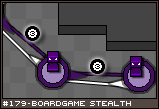|
Mechanic #179 - Boardgame Stealth |
 | Posted: Jan 14, 2014
Use color coded paths to create a complex stealth system for analog gaming. |
![[stealth1.png]](set09/img/entry179-stealth1.png)
Fig 179.1 - Busy Looking Illustration.
This is an idea for how to create simple, predictable AI movement in a board game, with an eye towards creating stealth gameplay. Stealth can generally be broken down into three elements: Movement, Line of Sight, and Alert.
The goals for movement is to create a non-alert patrol pattern, as well as a way for enemies to move most efficiently to a specific spot. This is accomplished by using a router table of sorts.
![[stealth2.png]](set09/img/entry179-stealth2.png)
Fig 179.2 - Nodes of Color.
The game world is made of of nodes, with each node containing a specific color (or multiple colors). These colors represent a single patrol path. In the above example, there are three patrol paths (purple, yellow, green), with the green patrol path overlapping both the yellow and purple patrol paths.
Each node has arrows pointing out of it, one for each color, indicating the quickest path to take towards that color's patrol path. For instance, if a pawn was on a yellow node, following the purple arrow would be the closest step towards the purple path. White arrows are used as a default. If there is no colored arrow available, take the white arrow instead (useful for combining multiple paths that all point in the same direction).
With arrows the same color as the current node, that indicates the next step to take on the current patrol path. So, if you are on a purple node and follow the purple arrows, you will take a leisurely stroll counter-clockwise around the purple patrol path.
![[stealth3.png]](set09/img/entry179-stealth3.png)
Fig 179.3 - Now there's little numbers.
Since there is no facing for a board game pawn, line of sight is instead based on the length of the paths connected to a node. If the length of the path is shorter than or equal to a pawn's vision rating, that pawn can see the next node. For instance, if a path has a length of 2 and the pawn has a vision of 3, the pawn can see the next node. Pawns can see down multiple paths, so a vision of 3 can see two nodes that are each 1 length away from each other.
This means that the player, who is trying to sneak around, must stay a certain radius away from the enemy in order to not be seen. He can be in adjacent nodes, as long as that node has a length long enough to put it out of range.
What happens when the player is spotted by an enemy? When a pawn sees a player, a curiosity token is placed on the player's node. Normally, pawns will follow the arrows around a patrol path, but if there is a neighboring curiosity token in their line of sight, they will move towards it instead. If they arrive at a curiosity token and there is no player, the token is removed and patrol continues.
If a pawn arrives at a node containing a player, however, the board goes into high alert and an alert token is placed at the player's last known position. ALL pawns on the board will immediately move towards the alert token, using the routing paths: if the alert token is on a purple node, pawns will follow the purple arrows. This does mean that pawns will follow the patrol path to get to the alert token, unless they can see it or a curiosity token.
In high alert, a countdown begins. Any time the player is engaged or seen in the line of sight of an enemy, the alert token is moved to his current position and the countdown starts over. If the player manages to stay out of line of sight for the entire countdown, the board ends high alert, and the pawns head back to their specific patrol paths, via the colored arrow routing.
- This idea is kind of an amalgamation of several different movement ideas I've seen in board games. Arkham Horror uses a white/black arrow system to randomly move monsters around, while Tannhauser uses colored circles to make line of sight explicit. But the biggest inspiration is routing tables, which route packets to computers based on ip address.
- Tannhauser, Routers, Arkham Horror
- Though I haven't played it (yet), Zombicide apparently has an alert system based on sound. If players perform a loud action, sound tokens are placed on the board. When zombies move, they first move towards any visible players if possible, then towards the sound tokens. I'm not sure how much more complicated that system is though. |